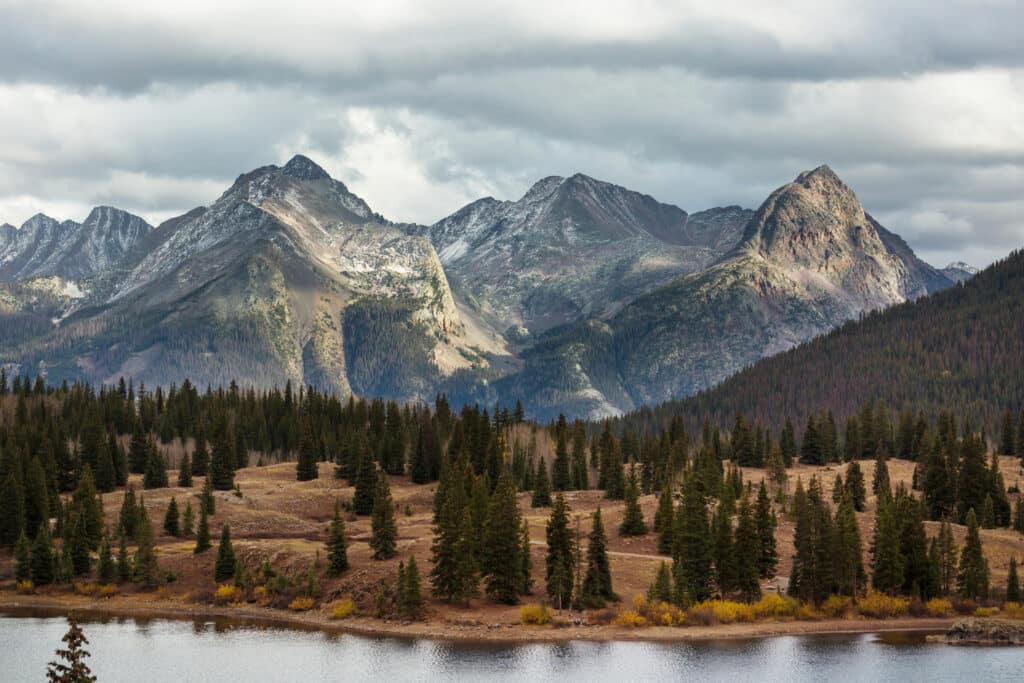How To Prepare For Your Trip to The Rockies
The Rocky Mountains of Colorado and Wyoming have some of the most beautiful scenery in North America. The area is a haven for outdoor enthusiasts, hikers, cyclists, skiers, and tourists of all kinds.
However, driving through the Rockies at any time of the year requires preparation. Distances between populated areas are great, and in many areas, services can be limited.
Snowstorms are regular occurrences from early fall through late spring, and weather conditions can change quickly year-round. Shorter days and lower temperatures are a concern in the fall and winter. Spring and summer can mean thunderstorms and sudden downpours. Limited visibility caused by fog can be a concern at any time.
To stay safe at any time of the year, preparation is key.

Prepare Your Vehicle
- Make sure you have the proper type of vehicle and equipment for the terrain and the weather you will be experiencing. Make sure your vehicle is outfitted with the proper tires, snow tires or chains, and other equipment.
- Before setting out, make sure your car has a full tank of gas, the tires are properly inflated, and the windshield wiper fluid is topped off. You might consider getting a full vehicle inspection before heading to the mountains.
- Make sure your car insurance covers things you might not think about, such as hail damage.
Getting There
- Check the weather before setting out. If you’re in any way concerned about the conditions, don’t go.
- Have your route entered into your navigation system or printed out before you leave. Phone service can be unreliable in the mountains, and you can’t rely on your smartphone to guide you.
- Tell someone where you’re going and when you expect to be back.
Plan For Emergencies
- Make sure you have an emergency kit in your car. This includes the essentials such as:
- Jumper cables
- Window scraper
- Snow brush
- Flashlight and batteries
- Spare tire
- Rope
- Water and food
- In the Rocky Mountains of Wyoming and Colorado, no matter what time of year, be prepared for abrupt changes in weather. Don’t forget to bring:
- Blankets (one for each passenger)
- Extra warm clothing
- Hat and gloves
- Emergency candle (for warmth)
- Shovel (to dig out your tires or car if you are caught in a blizzard)
- Traction aids (like kitty litter or planks of wood)
Accident Statistics In Colorado and Rocky Mountains Region
According to the National Park Service, motor vehicle accidents are the second leading cause of unintentional fatalities in national parks, with an average of one death each week. Most crashes occur during the daytime in summer months, when parks have the most visitors.
Drivers in the Rocky Mountains can encounter many different types of driving hazards, including wild animals, unfamiliar terrain, low visibility, and extreme or abruptly changing weather conditions. Given the variety of conditions that drivers face in the Rockies, it’s no surprise that mountain roads can be more treacherous than what a driver might encounter in other driving conditions.
In particular, some roads are known to be more dangerous, and this is where more accidents occur. Here are the statistics for accidents specifically in Colorado, and the road conditions in which those accidents took place.
TOTAL ACCIDENTS: 92,810
INJURIES
32,212
FATALITIES
639
VEHICLES
174,766
Weather and Road Conditions at the Time of the Accident:
ACCIDENTS IN THE SNOW
2,975
ACCIDENTS IN ICY ROADS
13,252
ACCIDENTS IN SLUSHY ROADS
805
ACCIDENTS IN WET ROADS
4,908
ACCIDENTS IN MUDDY ROADS
94
TOTAL ACCIDENTS: 102,166
INJURIES
37,467
FATALITIES
721
VEHICLES
190,674
Weather and Road Conditions at the Time of the Accident:
ACCIDENTS IN THE SNOW
3,811
ACCIDENTS IN ICY ROADS
14,275
ACCIDENTS IN SLUSHY ROADS
719
ACCIDENTS IN WET ROADS
7,027
ACCIDENTS IN MUDDY ROADS
90
TOTAL ACCIDENTS: 95,432
INJURIES
34,760
FATALITIES
764
VEHICLES
177,942
Weather and Road Conditions at the Time of the Accident:
ACCIDENTS IN THE SNOW
4,749
ACCIDENTS IN ICY ROADS
13,753
ACCIDENTS IN SLUSHY ROADS
895
ACCIDENTS IN WET ROADS
5,399
ACCIDENTS IN MUDDY ROADS
60
TOTAL ACCIDENTS: 97,849
INJURIES
36,015
FATALITIES
691
VEHICLES
183,628
Weather and Road Conditions at the Time of the Accident:
ACCIDENTS IN THE SNOW
3,070
ACCIDENTS IN ICY ROADS
11,131
ACCIDENTS IN SLUSHY ROADS
691
ACCIDENTS IN WET ROADS
5,091
ACCIDENTS IN MUDDY ROADS
97
TOTAL ACCIDENTS: 86,304
INJURIES
31,953
FATALITIES
622
VEHICLES
161,326
Weather and Road Conditions at the Time of the Accident:
ACCIDENTS IN THE SNOW
3,910
ACCIDENTS IN ICY ROADS
9,430
ACCIDENTS IN SLUSHY ROADS
709
ACCIDENTS IN WET ROADS
4,158
ACCIDENTS IN MUDDY ROADS
61
The Dangers of Driving into the Rocky Mountains without Proper Preparation
Driving in the Wyoming and Colorado mountains is very different from driving on flat roads. You have to contend with steep, winding, narrow roads, often with no guardrails. There is also the possibility of abrupt weather changes and animals jumping in front of you. Here are some of the dangerous situations you could encounter, and how to handle them.
- If a large animal – moose, elk, or deer, for example – jumps out in front of your vehicle and you can’t avoid hitting it, don’t slow down. Hit the gas instead. While this may sound counterintuitive, remember that the animal’s weight is in its body, not its legs. When you slow down, your car’s front end will dip, acting as a ramp for the animal to go straight through your windshield. Instead, speed up to increase the chances that the animal will go over your car.
- Don’t use your phone while driving, or drive while drowsy or under the influence of drugs, alcohol, or marijuana.
- Watch out for symptoms of altitude sickness, which could affect your driving and cause you to be less alert than normal. Mild symptoms include dizziness or light-headedness, fatigue, headache, loss of appetite, nausea or vomiting, rapid pulse (heart rate), or shortness of breath with exertion. Symptoms usually appear within 12 to 24 hours of reaching a higher elevation and then get better within a day or two as your body adjusts to the change in altitude. If you are experiencing any of these symptoms, make sure you stop and rest, stay hydrated, and don’t go any higher until your body starts adjusting. Use over-the-counter medicines like ibuprofen or Dramamine to treat headache or nausea.
- The use of cruise control is not recommended.
- Narrow mountain roads contain sharp turns and switchbacks. Limited visibility could lead to crashes with other vehicles. Plan to start early and complete your drive during daylight hours.
- Even if you are an experienced mountain driver, remember that you may be driving alongside many people who are new to the area. You will want to be especially careful in tourist-heavy areas, such Rocky Mountain National Park, Yellowstone, and ski resorts.
- In cold weather, watch out for black ice, especially on bridges and near water.
- Make sure you know how to descend steep mountain roads using a lower gear and pumping your brakes. This ensures that you don’t overheat your brakes going downhill at high speeds. When going uphill, downshift if your vehicle has a manual transmission.
- Watch out for animals on mountain roads, especially in remote areas. If you see wildlife near the road, slow down, in case they dart across the road. If you want to take photos, make sure you stop your vehicle in a safe location. Keep at a safe distance from the animal, and stay in your car if you see a bear.
- Don’t rely on GPS or your cell phone to find your way. Service is limited in many areas. Bring printed maps as a backup.
Expert Advice
UncoverColorado.com recommends that you not depend on cell phone coverage. “Don’t expect to be able to look up information on the go, especially if off the beaten highway. Plan your travel route in advance . . . but feel free to stray from your plans, ditch the phone and go with the flow. Bring a map just in case. When you are signaled in, pay attention to cotrip.org for update-to-date highway cameras of major through roads, as well as closures and alerts. Use it to check traffic conditions on your route, and any snow closures.”
When travelling on I-70, Breckenridge.com advises that the most important tips are to have good tires and know when not to be on the road. Know the summer and winter travel patterns, and make sure you avoid peak travel times. For winter travel patterns, check out these tips by blogger Tim de Rendon.
TripAdvisor.com’s Colorado Forum lists additional tips by locals, including staying in the right-hand lane unless passing, staying behind – not in front of – semi-trucks, and pulling over to let cars pass if traffic backs up behind you (this is required by law in Colorado). Additionally, if you are from the “lowlands,” you may want to get your car re-tuned for higher altitude driving.
This page provides detailed accident statistics for Colorado and the Rocky Mountains region, offering valuable insights for residents, journalists, and anyone researching traffic crash trends. All data is sourced from official Colorado crash reports to ensure accuracy and reliability.

